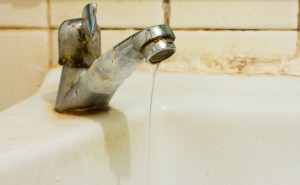We Need to Talk about Lead’s Role in the Cycle of Poverty

We need resources.
If there was one resounding takeaway from the Center for American Progress’s event last Wednesday on “Addressing Lead Exposure in Low-Income Communities,” it’s that efforts to remediate lead paint and other health hazards in old homes across the United States are desperately underfunded. Without increased spending on such efforts, the effects of lead exposure on individuals’ well-being and ability to achieve will persist among future generations.
Lead poisoning results from ingestion or inhalation of lead over time. As lead accumulates in the body, it interferes with cognitive development and can permanently impair a child’s mental abilities, as well as cause a disturbing array of physical maladies. High levels of lead in the environment are also correlated with an increase in violence and crime. Those most adversely affected are children in low-income communities, where many older homes and rental properties have not been remediated. The Center for American Progress (CAP) publication “Creating Safe and Healthy Living Environments for Low-Income Families” describes how “one’s health and life expectancy is determined more by ZIP code than genetic code.” CAP also explains that many of the hazardous housing conditions are in neighborhoods of “‘concentrated disadvantage,’ characterized by high rates of racial segregation, unemployment, single-parent families, and exposure to neighborhood violence.”
Despite these daunting challenges presented by lead poisoning, the solutions are relatively straightforward and have broad, positive impacts on low-income communities. Panelists advocated implementing a set of interventions to remediate lead hazards, along with policies to establish rigorous and enforceable environmental standards. These actions would require collective action from multiple government agencies such as Housing and Urban Development (HUD), the Environmental Protection Agency (EPA), the Centers for Disease Control (CDC), Medicare/Medicaid, the Internal Revenue Service (IRS), and the US Consumer Product Safety Commission, as well as support from public sector and private sector organizations. Cleaning up lead levels in old houses and efforts to decrease lead levels in urban soil would result in lower crime rates and lower rates of imprisonment, higher academic achievement, and less economic burden on healthcare systems. The advances for equity are obvious—as are the economic benefits, if the moral case is unpersuasive. According to estimates by Elise Gould at the Economic Policy Institute, there is a $17 to $221 return on each dollar of investment in lead hazard abatement, resulting in $181 to $269 billion in savings over time.
Despite the obvious outcomes across policy lines, insufficient investment is one of the biggest reasons lead paint in homes is still an issue in 2016, according to the CAP presentation panelists. Keynote speaker and current HUD Secretary Julian Castro (an early favorite for Clinton’s VP pick) cited the biggest challenge to investment as the government’s competing priorities at the local, state, and federal levels. President of Green and Healthy Homes Initiative (GHHI) Ruth Ann Norton stated that if Congress invested at least $250 million in lead abatement programs every year with matching support from private investment via social impact bonds, we’d be able to solve most of the problem within the next five years.
Mitigating lead exposure and the problems associated with it is an issue that has bipartisan support. Cleaning up lead in low-income communities would also advance efforts to close the racial gap in educational outcomes because people of color are disproportionately affected by lead and other health hazards related to older homes. Investing in our children should be a no-brainer, and it should be of particular concern to humanists, who realize that this is the only life we have and the only opportunity we have to improve living conditions for our fellow human beings. With the American Humanist Association’s recent focus on social justice, the humanist community should be raising awareness about the problems faced by low-income people of color. Lead poisoning and its relationship to the cycle of poverty is a relatively solvable issue that deserves more attention from humanists, who can put pressure on our elected officials to make this issue a priority.
